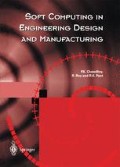Abstract
In recent theoretical and experimental work on schemata in genetic programming we have proposed a new simpler form of crossover in which the same crossover point is selected in both parent programs. We call this operator one-point crossover because of its similarity with the corresponding operator in genetic algorithms. One-point crossover presents very interesting properties from the theory point of view. In this paper we describe this form of crossover as well as a new variant called strict one-point crossover highlighting their useful theoretical and practical features. We also present experimental evidence which shows that one-point crossover compares favourably with standard crossover.
Access this chapter
Tax calculation will be finalised at checkout
Purchases are for personal use only
Preview
Unable to display preview. Download preview PDF.
References
John R. Koza, 1992, Genetic Programming; On the Programming of Computers by Means of Natural Selection, MIT Press, Cambridge, Massachusetts.
John R. Koza, 1994, Genetic Programming II: Automatic Discovery of Reusable Programs, MIT Press, Cambridge, Massachusetts.
K. E. Kinnear, Jr., Ed., 1994, Advances in Genetic Programming, MIT Press, Cambridge, Massachusetts.
John R. Koza, David E. Goldberg, David B. Fogel, and Rick L. Riolo, Eds., 1996, Genetic Programming 1996: Proceedings of the First Annual Conference, MIT Press, Cambridge, Massachusetts.
Peter J. Angeline and K. E. Kinnear, Jr., Eds., 1996, Advances in Genetic Programming 2, MIT Press, Cambridge, MA, USA.
Riccardo Poli, 1996, Genetic programming for image analysis, in Genetic Programming 1996: Proceedings of the First Annual Conference, Stanford University, CA, USA, July, pp. 363-368.
Riccardo Poli and Stefano Cagnoni, 1997, Genetic Programming with User-Driven Selection: Experiments on the Evolution of Algorithms for Image Enhancement, in Genetic Programming 1997: Proceedings of the Second Annual Conference, Stanford University, CA, USA, July, pp. 269-276.
Riccardo Poli, 1997, Discovery of symbolic, neuro-symbolic and neural networks with parallel distributed genetic programming, in 3rd International Conference on Artificial Neural Networks and Genetic Algorithms, ICANNGA′97, Norwich, UK.
Riccardo Poli, 1997, Evolution of recursive transistion networks for natural language recognition with parallel distributed genetic programming, in Proceedings of AlSB-97 Workshop on Evolutionary Computation, Manchester, UK.
William B. Langdon, 1996, A bibliography for genetic programming, in Advances in Genetic Programming 2, Peter J. Angelinc and K. E. Kinnear, Jr., Eds., appendix B, pp. 507–532, MIT Press, Cambridge, MA, USA.
John Holland, 1992, Adaptation in Natural and Artificial Systems, MIT Press, Cambridge, Massachusetts, second edition.
David E. Goldberg, 1989, Genetic Algorithms in Search, Optimization, and Machine Learning, Addison-Wesley, Reading, Massachusetts.
Una-May O’Reilly and Franz Oppacher, 1994, The troubling aspects of a building block hypothesis for genetic programming, in Foundations of Genetic Algorithms 3, Estes Park, Colorado, USA, July, pp. 73-88.
P. A. Whigham, 1995, A schema theorem for context-free grammars, in 1995 IEEE Conference on Evolutionary Computation, Perth, Australia, Nov, pp. 178-181.
Riccardo Poli and W. B. Langdon, 1997, A new schema theory for genetic programming with one-point crossover and point mutation, in Genetic Programming 1997: Proceedings of the Second Annual Conference, Stanford University, CA, USA, July, pp. 278-285.
Ben McKay, Mark J. Willis, and Geoffrey W. Barton, 1995, Using a tree structured genetic algorithm to perform symbolic regression, in First International Conference on Genetic Algorithms in Engineering Systems: Innovations and Applications, GALESIA, Sheffield, UK, Sept, pp. 487-492.
Riccardo Poli and W. B. Langdon, 1997, An experimental analysis of schema creation, propagation and disruption in genetic programming, Technical Report CSRP-97-8, University of Birmingham, School of Computer Science, Feb., To be presented at ICGA-97.
Patrik D’haeseleer, 1994, Context preserving crossover in genetic programming, in Proceedings of the 1994 IEEE World Congress on Computational Intelligence, Orlando, Florida, USA, June, pp. 256-261.
W. B. Langdon and R. Poli, 1997, Fitness causes bloat, in Proceedings of the Second On-line World Conference on Soft Computing (WSC2), Internet, June, 1997.
N. N. Schraudolph and R. K. Belew, 1992, Dynamic parameter encoding for genetic algorithms, Machine Learning, 9, pp. 9–21.
Darrel Whitley, 1993, A genetic algorithm tutorial, Tech. Rep. CS-93-103, Department of Computer Science, Colorado State University.
Author information
Authors and Affiliations
Editor information
Editors and Affiliations
Rights and permissions
Copyright information
© 1998 Springer-Verlag London
About this paper
Cite this paper
Poli, R., Langdon, W.B. (1998). Genetic Programming with One-Point Crossover. In: Chawdhry, P.K., Roy, R., Pant, R.K. (eds) Soft Computing in Engineering Design and Manufacturing. Springer, London. https://doi.org/10.1007/978-1-4471-0427-8_20
Download citation
DOI: https://doi.org/10.1007/978-1-4471-0427-8_20
Publisher Name: Springer, London
Print ISBN: 978-3-540-76214-0
Online ISBN: 978-1-4471-0427-8
eBook Packages: Springer Book Archive

